The Rise of the Chicago Police Department by Sam Mitrani

Author:Sam Mitrani
Language: eng
Format: epub
Publisher: University of Illinois Press
Published: 2014-03-14T16:00:00+00:00
CHAPTER 6
Carter Harrison Remakes the Chicago Police Department
The events of the 1870s set the stage for an unprecedented strengthening of the police department in the first half of the 1880s. At the beginning of that decade, the police force was undermanned and lacked legitimacy among the bulk of Chicago’s population. Elite observers continued to excoriate the police for corruption and inefficiency, while working-class Chicagoans had good reason to view the police as little more than servants of the rich. Temperance continued to loom as an issue that could only exacerbate these problems for the department. The city itself was more class divided than ever before, and both sides had created their own armed militias, in part because neither side trusted the police department. During the first half of the 1880s, Mayor Carter Harrison successfully addressed all of these issues by rehabilitating the department’s image and pouring resources into the force.
Harrison sought to create a more inclusive version of city politics that would neutralize the threat of worker upheaval, build a cross-class electoral alliance, and ensure order by both reducing class conflict and creating a police department that workers of all ethnicities would consider legitimate and useful. To do this, he pulled the police back from breaking strikes or disrupting anarchist meetings, gave the department a new set of social service responsibilities, and hired a more ethnically representative group of officers. These measures did not change the basic nature of policing—force remained the main tool that the police could deploy to address the broad range of social problems they confronted. They did, however, make possible a dramatic increase in the policing of Chicagoans’ daily lives, especially in areas like unwanted pregnancy, which had previously been the responsibility of the family, rather than the government. His policies also dramatically failed to ensure class peace, as his mayoralty culminated in the massive strikes for the eight-hour workday in 1886, the bombing at Haymarket, and the subsequent extralegal repression of the anarchists. They succeeded, however, in rebuilding the police department into a much more powerful and legitimate force.
In the late 1870s, the police were woefully undermanned. Even after the department’s successful suppression of the upheaval of 1877, Mayor Monroe Heath continued with his program of extreme fiscal retrenchment. Heath succeeded in restoring the city’s credit but had gutted its public services. There were far too few police still on the payroll to patrol the city effectively. Superintendent V. A. Seavey acknowledged this at the end of 1878, when the force employed a mere 409 men. He reported that each night patrolman had to cover an average of three and a quarter miles of street, while day patrolman were responsible for four and a half miles. As a result, “it should not be surprising if the cry of ‘where are the police’ is occasionally heard.”1 As the superintendents did each year, Seavey requested an increase in the size of the force. The crises of the 1870s had created a consensus among the city’s leaders that
Download
This site does not store any files on its server. We only index and link to content provided by other sites. Please contact the content providers to delete copyright contents if any and email us, we'll remove relevant links or contents immediately.
| Africa | Americas |
| Arctic & Antarctica | Asia |
| Australia & Oceania | Europe |
| Middle East | Russia |
| United States | World |
| Ancient Civilizations | Military |
| Historical Study & Educational Resources |
Cat's cradle by Kurt Vonnegut(14768)
Pimp by Iceberg Slim(13787)
Underground: A Human History of the Worlds Beneath Our Feet by Will Hunt(11842)
4 3 2 1: A Novel by Paul Auster(11800)
The Radium Girls by Kate Moore(11626)
Wiseguy by Nicholas Pileggi(5323)
American History Stories, Volume III (Yesterday's Classics) by Pratt Mara L(5139)
Perfect Rhythm by Jae(5076)
The Fire Next Time by James Baldwin(5024)
Paper Towns by Green John(4805)
Pale Blue Dot by Carl Sagan(4626)
A Higher Loyalty: Truth, Lies, and Leadership by James Comey(4556)
The Mayflower and the Pilgrims' New World by Nathaniel Philbrick(4285)
The Doomsday Machine by Daniel Ellsberg(4250)
Killers of the Flower Moon: The Osage Murders and the Birth of the FBI by David Grann(4192)
Too Much and Not the Mood by Durga Chew-Bose(4097)
The Sympathizer by Viet Thanh Nguyen(4096)
The Borden Murders by Sarah Miller(4025)
Sticky Fingers by Joe Hagan(3916)
